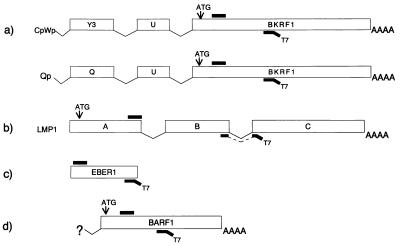FIG. 1.
Schematic representations of different types of EBV transcripts and localization of NASBA primers. (a) Transcript which is spliced in the noncoding but not the coding domain, like EBNA1 transcripts (10, 14, 21). All possible coding transcripts are detected by NASBA with primers localized within the ORF. (b) Transcript which is spliced in the coding domain, like LMP1 and LMP2 (12, 13). (c) Transcript which is not spliced at all, like EBER1 (6). (d) Transcript whose splicing pattern is not known, like BARF1 (27). Although the splicing patterns of the BamHIA region are highly complex, the selection of NASBA primers within the ORF of interest provides reliable detection without false negatives. Large open bars represent exons; small black bars represent NASBA primers. Abbreviations: ATG, start codon; AAAA, poly(A) tail; BKRF1, BamHIK rightward frame 1.

